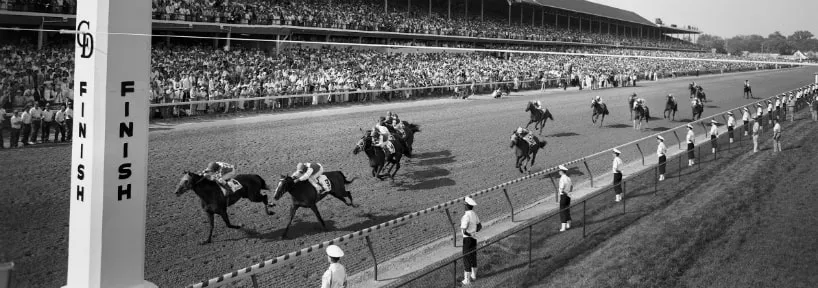The Kentucky Derby Betting Guide, Odds & Picks (2020)

The best way to attack a winning ticket for the Kentucky Derby is to break it into slices.
First, let’s have a look at the horses at the top of the betting boards and morning lines; you know them as the favorites. What are the top five factors we can count on from them? From there, we’ll dissect longshots for relevance. Do they really belong at the bottom, or are they just misunderstood? Lastly, we will wrap this up with some stone-cold locks that, if you don't have on your ticket, you aren't here to win.
Check out our guide to betting on horse racing here >>
Five Factors For Favorites
Pace
Pace is just marginal speed, or the speeds of a horse during different points of a race — beginning, middle, and end. This is essential not only to identify what a horse is consistently capable of, but also to predict their maximum potential.
Style
The more that a horse races in their career, the more they are defined by a particular style of running. These different styles, which come in a variety of forms, could reveal a horse is urged-to or prefers to run in a particular fashion.
Pedigree
A horse’s genetic makeup can lead their career down a plethora of pathways, usually identified at birth for planning optimal surface and distance races that they could excel on. The more refined the breeding between winning sires and dames, the higher the demand and fetched prices. It seems outlandish, but depending on the width or depth of the hoof, or the height, weight, or length of the horse, different zones of impact on the racing surface can tangibly influence their finishing position.
Speed
Horses may try running on dirt, turf, or synthetic surfaces in their career, with environmental factors furthering the diversity of the field. It's no secret that some horses perform better on one surface over another. While this is more of a guideline and not a rule, it is something to consider in collaboration with data from the horse, trainer, and jockey aboard.
Class
The term "class" is really a catch-all variable that handicappers use to separate horses depending on who they've raced against and how they did against them - often emphasizing lengths beaten, finishing position, size of the field, race purse, etc. How class data ends up as a singular number depends upon the individual assigning the values or the formula used by some of these big-name companies that produce them.
Two Factors for Longshots
Jockeys
When a horse arrives at the gate, you can't change their breakfast or workout times. Who they are as a racer is already defined, too, regardless of if we understand that spectrum yet or not. That said, there is one final variable that can make or break a horse's showing in the race — the jockey. Sometimes, all a misunderstood horse needs is a veteran mounter who can instantly recognize body language such as poise or unrest.
Unconventional Worth
If you're already a longshot, you’re invisible by conventional means. This means that your only mission is to be revealed. A horse only needs to stand out over its fellow neighbors, other longshots, to glimmer in a field of thoroughbreds. One or two advantages in the aspects of speed, surface performance, class, pace, or racing style, can turn two comparably fast horses into multi-length “socially distanced” opponents.
What do all of these factors have in common?
The greatest commonality among these is recency, or how far back to look. I think if a horse accomplished something within the last two years, it's within reach to achieve again.
If we dive further under the microscope, we must remember that what a horse did seven months ago isn't as relevant as what they did four months ago. It seems silly, but this is an easy concept to forget when reading the overwhelming pages of a racing form.
Sometimes, a quick pick of the fastest horse on paper is less daunting than an elaborately constructed formula. This will often equate to a more enjoyable experience at the track, not necessarily a more winning one, but one of undistracted picking on things that really matter like chili or cheese fries from the snack shack.
Betting Odds
The "True" Favorites
3/5 Tiz the Law ⭐⭐⭐⭐⭐
8/1 Authentic ⭐⭐⭐⭐⭐
20/1 Ny Traffic ⭐⭐⭐⭐
5/1 Honor A. P. ⭐⭐
15/1 Thousand Words ⭐
20/1 King Guillermo ⭐
The "Relevant" Longshots
30/1 Max Player ⭐⭐⭐⭐
50/1 South Bend ⭐⭐⭐
30/1 Money Moves ⭐⭐
30/1 Sole Volante ⭐
Best Bets (Under $250)
$10 Show: 2,15,18
$10 Exacta: 17 w 2,15,18
$2 Exacta 2,17,18 w 2,15,17,18
$4 Trifecta: 17 w 2,15,18 w 2,8,15,18
$1 Trifecta: 2,15,17,18 (box)
$1 Superfecta: 2,17,18 w 2,15,17,18 w 2,15,17,18 w 2,8,15,17,18
$1 Superfecta: 17 w 2,8,15,18 w 2,8,15,18 w 2,8,15,18
$.10 Superfecta: 2,8,15,17,18 (box)
$.10 Superfecta: 2,17,18 w 2,15,17,18 w 2,15,17,18 w 2,7,8,15,16,17,18
$1 Pentafecta: 17 w 2,8,15,18 w 2,8,15,18 w 2,8,15,18 w 2,8,15,18
Total = $241.20
Check out our guide to betting on horse racing here >>
Subscribe: Apple Podcasts | Spotify | Google Podcasts | Stitcher | RadioPublic | Breaker | Castbox | Pocket Casts
Whether you’re new to sports betting or a betting pro, our Sports Betting Strategy and Advice page is for you. You can get started with our 101 section — including 10 Sports Betting Tips for Beginners — or head to more advanced strategy — like Key Numbers When Betting Against the Spread — to learn more.
Spencer Weston is a featured writer at BettingPros. For more from Spencer, check out his archive and follow him @westonpicks.
